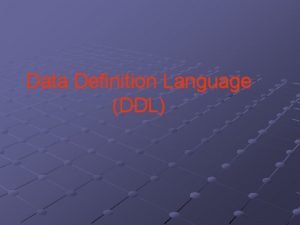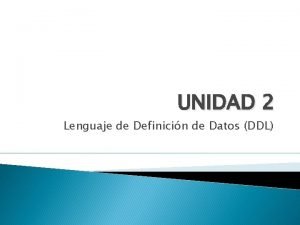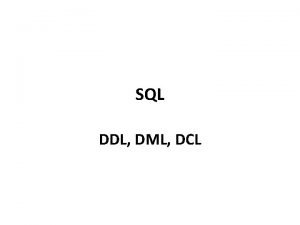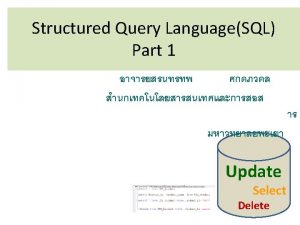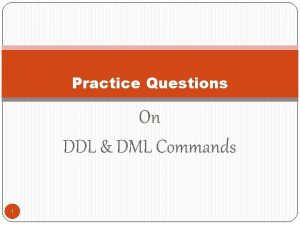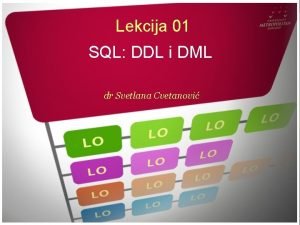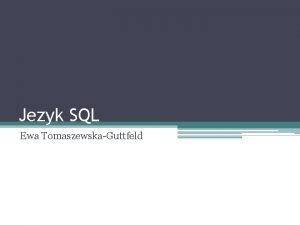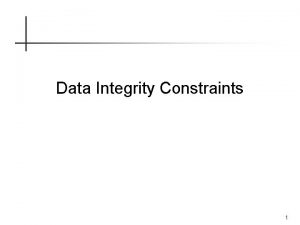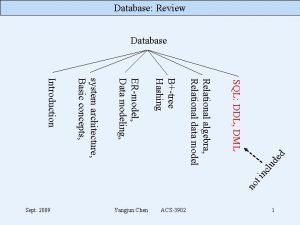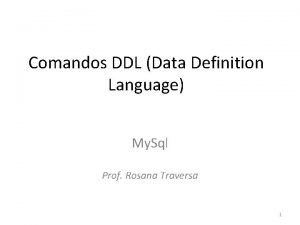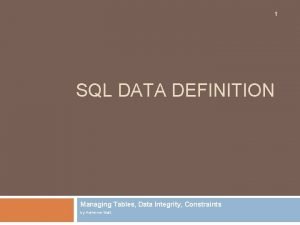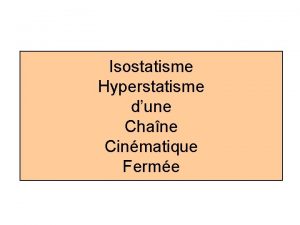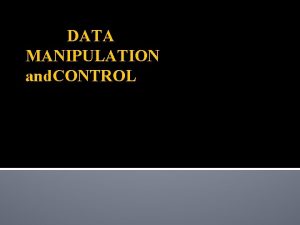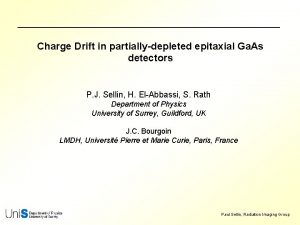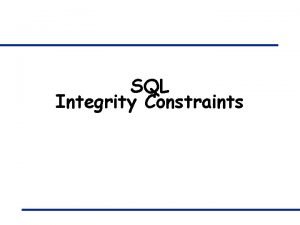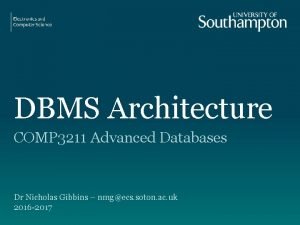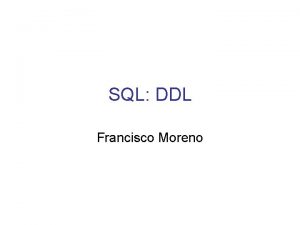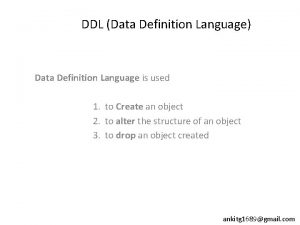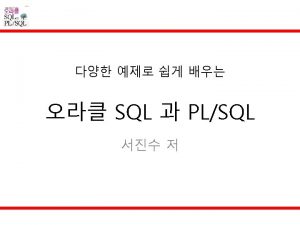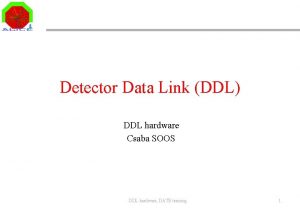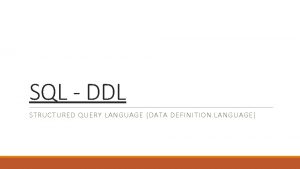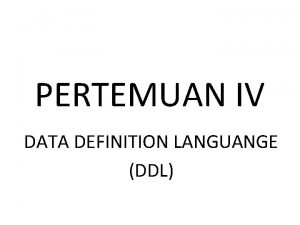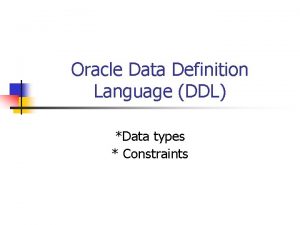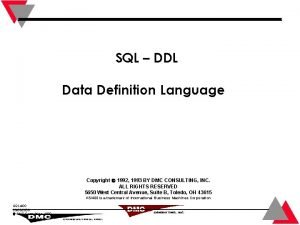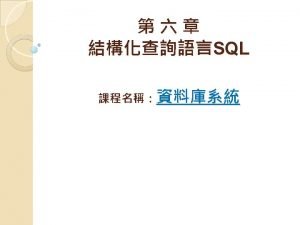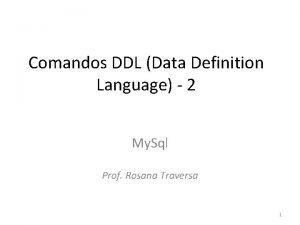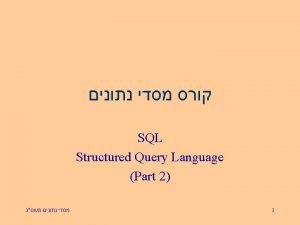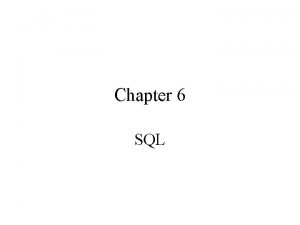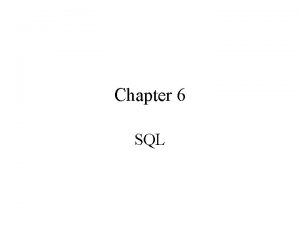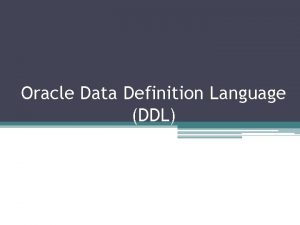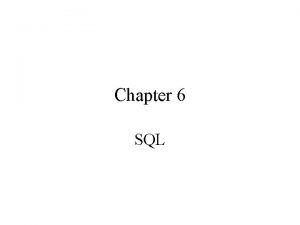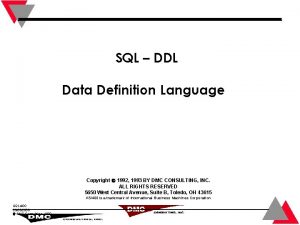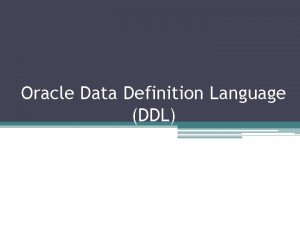Data Definition Language DDL DDL Data Definition Language






















- Slides: 22

Data Definition Language (DDL)

DDL Data Definition Language is used to define the structure of the database. DDL commands are auto committed i. e. the moment the user executes them, data is automatically saved. The user need not to use commit command.

DDL commands 1) 2) 3) 4) 5) Create Table Alter Table Truncate Table Rename Table Drop Table

CREATING AND MANAGING TABLES

Objectives After completing this lesson, you should be able to do the following: Describe the main database objects Create tables Describe the data types that can be used when specifying column definition Alter table definitions Drop, rename, and truncate tables

Database Objects Object Description Table Basic unit of storage; composed of rows and columns View Logically represents subsets of data from one or more tables Sequence Numeric value generator Index Improves the performance of some queries Synonym Gives alternative names to objects

Naming Rules Table names and column names: Must begin with a letter Must be 1– 30 characters long Must contain only A–Z, a–z, 0– 9, _, $, and # Must not duplicate the name of another object owned by the same user Must not be an Oracle server reserved word

Data Types Data Type Description VARCHAR 2(size) Variable-length character data (4000 char) CHAR(size) Fixed-length character data (255 char) NUMBER(p, s) Variable-length numeric data (38 digits) DATE Date and time values (DD-MON-YY) LONG Variable-length character data up to 2 gigabytes CLOB Character data up to 4 gigabytes RAW and LONG RAW Raw binary data BLOB Binary data up to 4 gigabytes BFILE Binary data stored in an external file; up to 4 gigabytes A 64 base number system representing the unique address of a row in its table. ROWID

The CREATE TABLE Statement You must have: CREATE TABLE privilege A storage area CREATE TABLE tablename (column datatype(size), …nth column datatype(size)); You specify: Table name Column name, column data type, and column size

Creating Tables Create the table. CREATE TABLE dept (deptno NUMBER(2), dname VARCHAR 2(14), loc VARCHAR 2(13)); Table created. Confirm table creation. DESCRIBE dept

Tables in the Oracle Database User Tables: Are a collection of tables created and maintained by the user Contain user information Data Dictionary: Is a collection of tables created and maintained by the Oracle Server Contain database information

The ALTER TABLE Statement Use the ALTER TABLE statement to: Add a new column Modify an existing column Define a default value for the new column Drop a column

The ALTER TABLE Statement Use the ALTER TABLE statement to add, modify, or drop columns. ALTER TABLE table ADD (column datatype [DEFAULT expr] [, column datatype]. . . ); ALTER TABLE table MODIFY (column datatype [DEFAULT expr] [, column datatype]. . . ); ALTER TABLE table DROP (column);

Adding a Column New column DEPT 80 “Add a new column to the DEPT 80 table. ” DEPT 80

Adding a Column You use the ADD clause to add columns. ALTER TABLE dept 80 ADD (job_id VARCHAR 2(9)); Table altered. The new column becomes the last column.

Modifying a Column You can change a column’s data type, size, and default value. ALTER TABLE dept 80 MODIFY (last_name VARCHAR 2(30)); Table altered. A change to the default value affects only subsequent insertions to the table.

Dropping a Column Use the DROP COLUMN clause to drop columns you no longer need from the table. ALTER TABLE dept 80 DROP COLUMN job_id; Table altered.

Dropping a Table All data and structure in the table is deleted. Any pending transactions are committed. All indexes are dropped. You cannot roll back the DROP TABLE statement. DROP TABLE dept 80; Table dropped.

Changing the Name of an Object To change the name of a table, view, sequence, or synonym, you execute the RENAME statement. RENAME dept TO detail_dept; Table renamed. You must be the owner of the object.

Truncating a Table The TRUNCATE TABLE statement: Removes all rows from a table Releases the storage space used by that table TRUNCATE TABLE detail_dept; Table truncated. You cannot roll back row removal when using TRUNCATE. Alternatively, you can remove rows by using the DELETE statement.

Adding Comments to a Table You can add comments to a table or column by using the COMMENT statement. COMMENT ON TABLE employees IS 'Employee Information'; Comment created. Comments can be viewed through the data dictionary views: ALL_COMMENTS USER_COL_COMMENTS ALL_TAB_COMMENTS USER_TAB_COMMENTS

Summary In this lesson, you should have learned how to use DDL statements to create, alter, drop, and rename tables. Statement Description CREATE TABLE Creates a table ALTER TABLE Modifies table structures DROP TABLE Removes the rows and table structure RENAME Changes the name of a table, view, sequence, or synonym TRUNCATE Removes all rows from a table and releases the storage space COMMENT Adds comments to a table or view
 Definition of ddl
Definition of ddl Ddl base de datos
Ddl base de datos Ddl lesson plan
Ddl lesson plan Dcl sql
Dcl sql Create alter drop truncate are ddl commands
Create alter drop truncate are ddl commands Ddl ringraumdichtung
Ddl ringraumdichtung Dml commands
Dml commands Dml naredbe
Dml naredbe Rodzaje instrukcji
Rodzaje instrukcji Challenges n 631 ddl
Challenges n 631 ddl Integrity constraints types
Integrity constraints types Ddl and dml
Ddl and dml Language
Language Challenges n 732 ddl
Challenges n 732 ddl Biba n 477 ddl
Biba n 477 ddl Hyperstatisme
Hyperstatisme Ddl stands for
Ddl stands for Drift away ddl
Drift away ddl Sql languages in dbms
Sql languages in dbms Otis ddl
Otis ddl Getting a drivers license illegally may result in
Getting a drivers license illegally may result in Sql integrity constraints
Sql integrity constraints Ddl compiler
Ddl compiler
